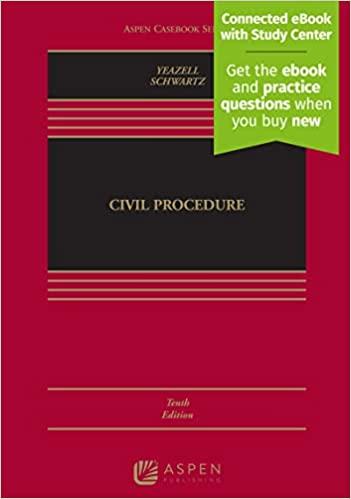Question
Referring to the precedents for a claim for money owed pursuant to an unpaid promissory note in appendix 3.1 ( Parrish v. Thurston ) and
Referring to the precedents for a claim for money owed pursuant to an unpaid promissory note in appendix 3.1 (Parrish v. Thurston) and appendix 4.4 (Greco v. Hardwick), draft a plaintiff's claim. The claim will be prepared as of April 21, 201-.
You work for Prior Mustafa LLP, 22 County Court Boulevard, Brampton, ON A1A 2B3 TEL: 905 111 2222 FAX: 905 111 2233. Your client is Francesca Elena Dante. Ms. Dante lives at 98 Calendar Court, Mississauga, Ontario X2X 3Y4 TEL: 905 111 2222.
On December 1, 201-, Ms. Dante loaned $4,000.00 to her best friend, Suzanne Maria Herrero. Ms. Herrero lives at 105 Morton Avenue, Mississauga, Ontario L2X 4Y5. The loan is secured by a promissory note dated December 1, 201- signed by Ms. Herrero. The terms of the note are as follows:
By her signature hereto, the undersigned SUZANNE HERRERO acknowledges receipt of the sum of FOUR THOUSAND DOLLARS ($4,000.00), paid by Francesca Elena Dante to Suzanne Maria Herrero on today's date. Interest shall be payable on said sum at a rate of 12% per annum, commencing December 1, 201-. The entire principal amount plus interest thereon shall be due and payable in full on March 1, 201-(+1). In the event of default by Suzanne Herrero, interest shall continue to accrue at a rate of 12% per annum until such time as all amounts owing are paid in full or judgment is obtained, and post-judgment interest shall accrue on the judgment amount, including costs, at a rate of 12% per annum until such time as the amount owing is paid in full.
On March 1, 201-(+1), Ms. Herrero gave Ms. Dante a cheque in the amount of $4,120.00, on account of the principal owing of $4,000.00 plus three months' interest of $120.00. The cheque was returned due to insufficient funds. An NSF charge of $37.50 was debited from Ms. Dante's account.
Ms. Dante comes to see you on March 27, 201-(+1). She has phoned and emailed Ms. Herrero several times to demand payment but has received no response. The last time she called the telephone number she has for Ms. Herrero, it was out of service. She wants to sue Ms. Herrero for the amount owing.
Calculating Damages
This is a straightforward case of an unpaid loan of money. Fortunately, Ms. Dante had the good sense to write down the terms of the loan in the promissory note signed by Ms. Herrero. When calculating the amount owing, all you have to do is refer to the terms of the note.
The only additional amount to be claimed will be the NSF charge. It should be claimed separately from the principal amount owing under the promissory note, because the terms for calculating interest set out in the note do not apply to the bank charge.
Dante v. Herrero: Calculating Pre-judgment Interest to the Date of the Plaintiff's Claim Using a Contractual Rate
For purposes of the following interest calculation, assume that the plaintiff's claim is dated April 3, 201-.
The NSF charge is excluded from the calculation because the terms for calculating interest set out in the note do not apply to the bank charge.
Step one: Calculate the per diem interest.
Per diem interest is the amount of interest that accrues on a daily basis. To calculate per diem interest, you must first convert the interest rate from a percentage out of 100 to a decimal. In the example above, the interest rate is 12%, or
12/100. If you divide 12 by 100, you will get the decimal form.12.
To calculate the per diem interest, multiply the amount owing as of the due date ($4,120.00) by the interest rate of 12%, or .12, stated in the promissory note. Then divide the result by 365that is, the number of days in a year.
.12 4120 = 494.40
494.40 365 = $1.35 per day in interest
Step two: Calculate the number of days that have elapsed since interest began to run.
Pre-judgment interest on the amount claimed of $4,120.00 begins to run on March 1, 201-, the date of default. Pre-judgment interest will be calculated from March 1, 201- to April 3, 201-the date the plaintiff's claim was issued.
Table 4.1 makes it easy to calculate the number of days that have elapsed between one date and the next. You simply find the number (from 1 to 365) for the start date (in this case, the date of default, March 1), and subtract that number from the number for the end date (in this case, April 3, the date the claim was issued).
March 1 is the 60th day in the year. April 3 is the 93rd day in the year.
93 - 60 = 33 days
Step by Step Solution
There are 3 Steps involved in it
Step: 1

Get Instant Access to Expert-Tailored Solutions
See step-by-step solutions with expert insights and AI powered tools for academic success
Step: 2

Step: 3

Ace Your Homework with AI
Get the answers you need in no time with our AI-driven, step-by-step assistance
Get Started


